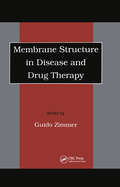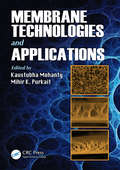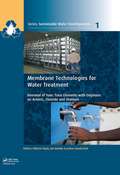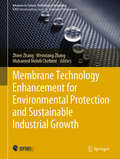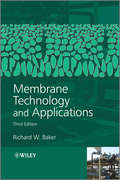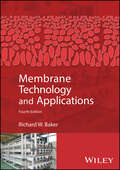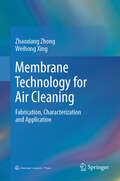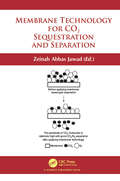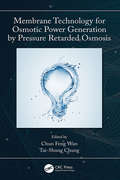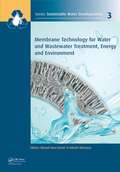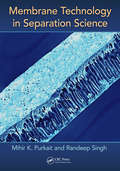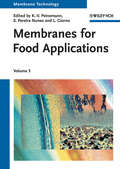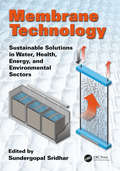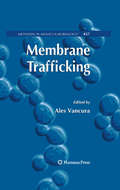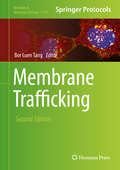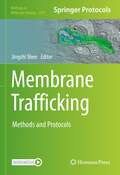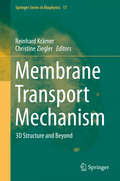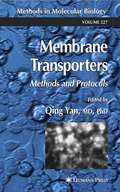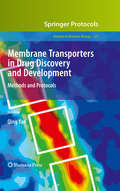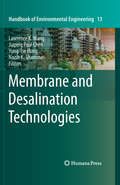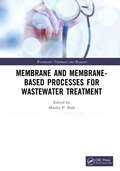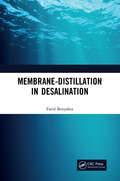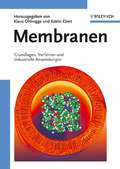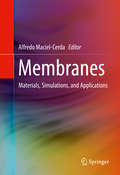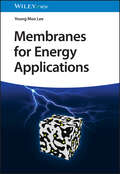- Table View
- List View
Membrane Structure in Disease and Drug Therapy
by Svante CornellThis study asserts that cellular and intracellular membranes are active in every aspect of the body's physiology and pathophysiology. It compares secondary through to quaternary structures and protien sequences and guages their influence on health, disease and drug therapy. The book highlights the importance of correlations, homologies and categori
Membrane Technologies and Applications
by Mihir K. Purkait Kaustubha MohantyCompiling recent advances in membrane separations technology, this highly relevant book introduces cost-effective solutions for separation problems in a wide range of industries. It discusses membrane use in water and wastewater treatment; food and dairy industry and fuel cell applications. It describes the role of membrane technologies in resource recovery, pollution prevention, and energy production, as well as environmental monitoring and quality control. A concise resource for emerging technologies, this book provides the tools to implement effective production processes, improve environmental protection and public health, and explore new opportunities for the industry.
Membrane Technologies for Water Treatment: Removal of Toxic Trace Elements with Emphasis on Arsenic, Fluoride and Uranium (Sustainable Water Developments - Resources, Management, Treatment, Efficiency and Reuse #1)
by Jan Hoinkis Alberto Figoli Jochen BundschuhFocuses on the application of membrane technologies in removing toxic metals\metalloids from water. Particular attention is devoted to the removal of arsenic, uranium, and fluoride. These compounds are all existing in the earth’s crust at levels between two and five thousands micrograms per kg (parts per million) on average and these compounds can be considered highly toxic to humans, who are exposed to them primarily from air, food and water. In order to comply with the new maximum contaminant level, numerous studies have been undertaken to improve established treatments or to develop novel treatment technologies for removing toxic metals from contaminated surface and groundwater. Among the technologies available, applicable for water treatment, membrane technology has been identified as a promising technology to remove such toxic metals from water. The book describes both pressure driven (traditional processes, such as Nanofiltration, Reverse Osmosis, Ultrafiltration,etc) and more advanced membrane processes (such as forward osmosis, membrane distillation, and membrane bio-reactors) employed in the application of interest. Key aspect of this book is to provide information on both the basics of membrane technologies and on the results depending on the type of technology employed.
Membrane Technology Enhancement for Environmental Protection and Sustainable Industrial Growth (Advances in Science, Technology & Innovation)
by Mohamed Mehdi Chehimi Zhien Zhang Wenxiang ZhangThis book presents a detailed discussion of the fundamentals and practical applications of membrane technology enhancement in a range of industrial processes, energy recovery, and resource recycling. To date, most books on the applications of membrane technology have mainly focused on gas pollution removal or industrial wastewater treatment. In contrast, the enhancement of various membrane processes in the areas of energy and the environment has remained largely overlooked. This book highlights recent works and industrial products using membrane technology, while also discussing experiments and modeling studies on the membrane enhancement process.
Membrane Technology and Applications
by Richard W. Baker"... the best handbook on membrane technology, which is currently on the market... " -Membrane News (on the previous edition)Building on the success of the previous edition, Membrane Technology and Applications Third Edition provides a comprehensive overview of separation membranes, their manufacture and their applications. Beginning with a series of general chapters on membrane preparation, transport theory and concentration polarization, the book then surveys several major areas of membrane application in separate chapters. Written in a readily accessible style, each chapter covers its membrane subject thoroughly, from historical and theoretical backgrounds through to current and potential applications. Topics include reverse osmosis, ultrafiltration, pervaporation, microfiltration, gas separation and coupled and facilitated transport; chapters on electrodialysis and medical applications round out the coverage.NEW TO THE THIRD EDITIONNew sections on the use of membranes in the chlor-alkali industry, membrane distillation, pressure retarded osmosis and constant flux-variable pressure ultrafiltrationZeolite and ceramic membranes, submerged membrane modules, and fuel cell membranesSubstantially enhanced chapters on ultrafiltration, pervaporation and membrane contactorsUpdates to every chapter to reflect the developments in the field
Membrane Technology and Applications
by Richard W. BakerMembrane Technology and Applications Internationally acknowledged text on separation membrane technology, presenting current theory and practice, plus manufacturing and applications The 4th Edition of Membrane Technology and Applications presents an authoritative, up-to-date overview of separation membranes, their theoretical underpinnings, manufacture, and use, beginning with a series of general chapters on membrane preparation, transport theory, and concentration polarization, then surveying the major areas of membrane application in separate chapters. Written in a readily accessible style, each chapter offers a thorough treatment of its subject, from historical and theoretical backgrounds through to current and potential applications. Topics include reverse osmosis, ultrafiltration, microfiltration, gas separation, pervaporation, electrodialysis, coupled and facilitated transport, and medical applications of membranes. This new edition has been comprehensively updated, with substantial new material, figures, and references throughout to reflect the latest developments in the field. Major changes include: A new chapter on transport mechanisms in finely microporous membranes, with focus on gas transport A new chapter on membrane contactors A substantially expanded section on hyperfiltration applications, including pharmaceutical applications, in the reverse osmosis chapter Expanded treatment of membrane bioreactors, plus a new section on biotechnology applications, in the ultrafiltration chapter A new section in the gas separation chapter devoted to carbon dioxide capture from industrial process emissions, including power plant emissions Research areas that the author would work on if he were, once again, a 21-year-old graduate student. Written by a leading expert with 50 years of experience, Membrane Technology and Applications provides balanced coverage of all aspects of the field, and is essential reading for all membrane enthusiasts, from neophyte graduate student to academic researcher to seasoned industry professional.
Membrane Technology for Air Cleaning: Fabrication, Characterization and Application
by Zhaoxiang Zhong Weihong XingThis book highlights a comprehensive and systematic introduction to the science and technology of gas cleaning membranes. Starting from basic concepts and principles, the book covers the preparation methods, performance parameters, and advances in applications of different types of membrane materials. Industrial smoke and dust emissions are one of the main causes of atmospheric haze. How to strictly control the emission of ultrafine dust and achieve efficient and clean utilization of resources is a common problem faced by industries related to chemical engineering, energy, steel, metallurgy, and building materials. There is an urgent need for new separation technologies. The low efficiency of traditional dust removal technologies cannot meet increasingly strict emission requirements. Membrane technologies provide an effective approach for PM2.5 control with its high separation efficiency and low energy consumption. Especially for the purification of high-temperature gases, it can maximize the utilization of the physical sensible heat of the gas and achieve energy recovery. This book first introduces relevant concepts and terms, separation principles, structure characterization, and evaluation methods of gas cleaning membranes. According to the characteristics of application environments, the preparation methods, performance parameters and application progress of different types of membrane materials, including those for medium and low temperature gases, high temperature gases as well as multi-functional membranes, are described in detail. Relevant equipment and typical application cases in indoor air purification, medical, and industrial fields are discussed. The book also summarizes latest theoretical research frontiers and projects future development trends in this field. This book can be used as a valuable reference for undergraduate and graduate students in materials science, chemical engineering, environmental engineering and researchers engaged in the development of air filtration materials and gas purification technology. The English translation of this book, originally in Chinese, was facilitated by artificial intelligence. The content was later revised by the author for accuracy.
Membrane Technology for CO2 Sequestration
by Zeinab Abbas JawadThis book addresses the fundamentals of CO2 storage for long-term sequestration in a subsurface geologic formation. In general, membrane gas separation can find a large room of application in flue gas. To achieve the development of this technology on a larger scale than which is possible in the lab we have to use membrane engineering. Consequently, greater emphasis is placed on novel materials for gas separation. Possible design strategies and role of novel materials are discussed. Additionally, the latest progress in design and preparation of asymmetric membranes for natural gas purification are highlighted. In fact, further development should focus on module and process design in order to bring gas separation membrane technology into commercial application. Therefore, the keys issues to propel current research towards industrial application are examined. Besides, the feasibility of implementing polyimide membrane for CO2 removal under real industrial conditions and its economic viability are highlighted. In order to exhibit excellent film-forming properties, zeolite membrane and cellulose acetate butyrate membrane areaddressed. Interestingly, it was found that the most accurate theoretical three-phase model is arguably revised Pal model with average percentage error of 0.74%.
Membrane Technology for Osmotic Power Generation by Pressure Retarded Osmosis
by Tai-Shung Chung Chun Feng WanOsmotic energy can be effectively harvested through pressure retarded osmosis (PRO) which is the most widely investigated technology due to its greater efficiency and higher power density output and effective membranes are the heart of the PRO technology. This book will cover a broad range of topics, including PRO membranes, fouling, module fabrication, process design, process operation and maintenance. It summarizes the progress in PRO researches in the last decade, and points out the directions for future R&D and commercialization of PRO. It will be of great interest to membrane researcher, company and operators to understand and get insights into the state-of-the-art PRO technologies.
Membrane Technology for Water and Wastewater Treatment, Energy and Environment (Sustainable Water Developments - Resources, Management, Treatment, Efficiency and Reuse)
by Takeshi Matsuura Ahmad Fauzi IsmailRealizing that water, energy and food are the three pillars to sustain the growth of human population in the future, this book deals with all the above aspects with particular emphasis on water and energy. In particular, the book addresses applications of membrane science and technology for water and wastewater treatment, energy and environment. Th
Membrane Technology in Separation Science
by Mihir K. Purkait Randeep SinghThe book explains fundamental and advanced topics related to the field of membrane science including extensive coverage of material selection, preparation, characterization and applications of various membranes. <P><P>Explores both preparation and wide range of applications for all possible membranes, contains an exclusive chapter on functionalized membranes and incorporation of stimuli responsive membranes in each type and includes exercise problems after each chapter <P><P>It also discusses new membrane operations as membrane reactors and membrane contactors
Membrane Technology, Volume 3: Membranes for Food Applications, 1st Edition
by Klaus-Viktor Peinemann Lidietta Giorno Suzana Pereira NunesEdited by an internationally recognized leader in the field, this third volume in the series represents the complete reference to membrane processes in the food industry. The handbook adopts a highly practical approach to this hot topic, combining the hands-on experience of the expert authors involved. They provide chapters devoted to such varied applications as dairy fractionation, electrodialysis, pressure-driven membrane processes in alcoholic beverages, membrane emulsification, contactors and bioreactors, as well as membranes for food packaging.
Membrane Technology: Sustainable Solutions in Water, Health, Energy and Environmental Sectors
by Sundergopal SridharContributed by multiple experts, the book covers the scientific and engineering aspects of membrane processes and systems. It aims to cover basic concepts of novel membrane processes including membrane bioreactors, microbial fuel cell, forward osmosis, electro-dialysis and membrane contactors. Maintains a pragmatic approach involving design, operation and cost analysis of pilot plants as well as scaled-up counterparts
Membrane Trafficking
by Ales VancuraAs membrane trafficking research has expanded over the past thirty years, a remarkable convergence of information has been gained by using genetic approaches in yeast cells with biochemical approaches in mammalian cells. This book reflects these advances by devoting one section of the book to yeast cells and the other to mammalian cells, with each section providing both classic and cutting-edge techniques to study macromolecular transport across the membranes.
Membrane Trafficking
by Bor Luen TangThis second edition explores membrane trafficking research that has been at the frontier of cell and molecular biology. In the past 20 years, this field has witnessed a remarkable convergence and synergism from information gained using genetic approaches in yeast cells, and biochemical and molecular approaches in mammalian cells. This volume contains updated chapters and the inclusion of a large number of new chapters, and is divided into three parts. Part I includes biochemical and molecular genetics approaches and methods used in analysing membrane traffic, in both yeast and mammalian cell models. Part II focuses on imaging and microscopy approaches and techniques, while Part III highlights the Omics-type approaches. Written in the highly successful Methods in Molecular Biology series format, chapters include introductions to their respective topics, lists of the necessary materials and reagents, step-by-step, readily reproducible laboratory protocols, and tips on troubleshooting and avoiding known pitfalls. Cutting-edge and resourceful, Membrane Trafficking, Second Edition, is a valuable resource for both experienced researchers, graduate students, and junior scientists in the field of membrane trafficking.
Membrane Trafficking: Methods and Protocols (Methods in Molecular Biology #2473)
by Jingshi ShenThis detailed volume presents a series of methods exploring membrane trafficking research, ranging from genetics and high-resolution imaging to in vitro biochemical and biophysical assays. Covering virtually all the major trafficking branches, the book delves into the exocytic pathway, which focuses on cargo transport from the ER to the Golgi, through the Golgi cisternae, and to the plasma membrane and the extracellular space; the endocytic pathway, which includes cargo endocytosis, endosomal recycling, and lysosomal degradation; as well as emerging topics beyond the conventional exocytic and endocytic pathways. Written for the highly successful Methods in Molecular Biology series, chapters include introductions to their respective topics, lists of the necessary materials and reagents, step-by-step, readily reproducible laboratory protocols, and tips on troubleshooting and avoiding known pitfalls. Authoritative and practical, Membrane Trafficking: Methods and Protocols provides techniques with broad applications as an ideal guide for junior researchers new to membrane trafficking as well as established membrane biologists seeking to expand their research programs.
Membrane Transport Mechanism
by Christine Ziegler Reinhard KrämerThis book provides a molecular view of membrane transport by means of numerous biochemical and biophysical techniques. The rapidly growing numbers of atomic structures of transporters in different conformations and the constant progress in bioinformatics have recently added deeper insights The unifying mechanism of energized solute transport across membranes is assumed to consist of the conformational cycling of a carrier protein to provide access to substrate binding sites from either side of a cellular membrane. Due to the central role of active membrane transport there is considerable interest in deciphering the principles of one of the most fundamental processes in nature: the alternating access mechanism This book brings together particularly significant structure-function studies on a variety of carrier systems from different transporter families: Glutamate symporters, LeuT-like fold transporters, MFS transporters and SMR (RND) exporters, as well as ABC-type importers The selected examples impressively demonstrate how the combination of functional analysis, crystallography, investigation of dynamics and computational studies has made it possible to create a conclusive picture or more precisely, "a molecular movie". Although we are still far from a complete molecular description of the alternating access mechanism, remarkable progress has been made from static snapshots towards membrane transport dynamics.
Membrane Transporters
by Qing YanThis collection of cutting-edge methodologies for studying membrane transporters and channels takes advantage of all the latest developments in biomedical research, including pharmacogenomcs, bioinformatics, and microarray technologies. The authors explain databases and tools for bioinformatics studies, provide practical guidelines for microarray experiments and data analysis, and illustrate the use of small angle X-ray scattering, nuclear magnetic resonance (NMR), and molecular modeling to study the structural biology of membrane transporters. Methods for exploring structure-function correlation, such as site-directed mutagenesis, immunocytochemistry, and confocal microcopy are also described, along with several that may help in the development of novel therapeutics.
Membrane Transporters in Drug Discovery and Development
by Qing YanStudies of membrane transporters have had a great impact on our understanding of human diseases and the design of effective drugs. In Membrane Transporters in Drug Discovery and Development: Methods and Protocols, expert researchers provide practical methodologies of the ongoing research on membrane transporters, considering applications of transporter technologies in drug discovery and development. Chapters include new and useful fields and methodologies, including pharmacogenomics, nutrigenomics, systems biology, bioinformatics, nuclear magnetic resonance (NMR), imaging, and quantitative real-time-PCR. Transporter studies in drug discovery and development for various diseases are discussed, including neuropsychiatric disorders, cardiovascular diseases, ophthalmic diseases, cancer, and diabetes. Composed in the highly successful Methods in Molecular BiologyTM series format, each chapter contains a brief introduction, step-by-step methods, a list of necessary materials, and a Notes section which shares tips on troubleshooting and avoiding known pitfalls. Wide-ranging and current, Membrane Transporters in Drug Discovery and Development: Methods and Protocols delivers a collection of practical protocols that can be used immediately in the lab, along with critical surveys of key topics by leading researchers in the field.
Membrane and Desalination Technologies
by Lawrence K. Wang Yung-Tse Hung Nazih K. Shammas Jiaping Paul ChenIn this essential new volume, Volume 13: Membrane and Desalination Technologies, a panel of expert researchers provide a wealth of information on membrane and desalination technologies. An advanced chemical and environmental engineering textbook as well as a comprehensive reference book, this volume is of high value to advanced graduate and undergraduate students, researchers, scientists, and designers of water and wastewater treatment systems. This is an essential part of the Handbook of Environmental Engineering series, an incredible collection of methodologies that study the effects of pollution and waste in their three basic forms: gas, solid, and liquid. Chapters adopt the series format, employing methods of practical design and calculation illustrated by numerical examples, including pertinent cost data whenever possible, and exploring in great detail the fundamental principles of the field. Volume 13: Membrane and Desalination Technologies is an essential guide for researchers, highlighting the latest developments in principles of membrane technology, membrane systems planning and design, industrial and municipal waste treatments, desalination requirements, wastewater reclamation, biofiltration, and more.
Membrane and Membrane-Based Processes for Wastewater Treatment (Wastewater Treatment and Research)
by Maulin P. ShahThe proposed book mainly sorts out emerging and burning issues faced day to day by municipal and industrial wastewater treatments. It also provides a comprehensive view of recent advances in hybrid treatment technologies for wastewater treatment, addresses the current limitations and challenges of applying these tools in wastewater treatment systems. This book gives an insight about recent developments in membrane technology for wastewater treatment. Industrial wastewater contains a large variety of compounds, such as heavy metals, salts and nutrients, which makes its treatment challenging. Thus, the use of conventional water treatment methods is not always effective. In this sense, membrane-based hybrid processes have emerged as a promising technology to treat complex industrial wastewater. The present book analyses and discusses the potential of membrane-based hybrid processes for the treatment of complex industrial wastewater along with the recovery of valuable compounds and water reutilization. In addition, recent and future trends in membrane technology are highlighted. FEATURES 1. The properties, mechanisms, advantages, limitations and promising solutions of different types of membrane technologies are discussed. 2. The optimization of process parameters is addressed. 3. The performance of different membranes is described. 4. The potential of nanotechnology to improve the treatment efficiency of wastewater treatment plants is presented. 5. The application of membrane and membrane-based hybrid treatment technologies for wastewater treatment is covered.
Membrane-Distillation in Desalination
by Farid BenyahiaMembrane-Distillation in Desalination is an attempt to provide the latest knowledge, state of the art and demystify outstanding issues that delay the deployment of the technology on a large scale. It includes new updates and comprehensive coverage of the fundamentals of membrane distillation technology and explains the energy advantage of membrane distillation for desalination when compared to traditional techniques such as thermal or reverse osmosis. The book includes the latest pilot test results from around the world on membrane distillation desalination.
Membranen: Grundlagen, Verfahren und Industrielle Anwendungen
by Grundlagen Verfahren und industrielle AnwendungenVon der Membran zum Verfahren - Der Einsatz von Membranverfahren in der chemischen Industrie weitet sich ungebremst aus. Als saubere und energiesparende Alternative zu herkömmlichen Trennverfahren halten die Membranverfahren weiterhin Einzug in vielfältige industrielle Anwendungen. Fest eingeführt sind solche Verfahren u. a. in der Gastrennung und der organophilen Filtration, und neue Perspektiven eröffnen sich für katalytische Reaktionen in Membranreaktoren. Die Membrantechnik ist die optimale Lösung bei der Behandlung von industriellen Abfällen ebenso wie für die kontrollierte Herstellung wertvoller Chemikalien. Das Buch behandelt die Grundlagen der Membranverfahrenstechnik über Modulkonfigurationen, Flüssig- und Gastrennung bis hin zu Membranen in der Brennstoffzelle, Medizintechnik und der Lebensmittelindustrie. Es ist eine wertvolle Informationsquelle für Praktiker und Betriebsingenieure ebenso wie für Neueinsteiger, die ein umfassendes Bild über die Anwendung von Membranen in der Verfahrenstechnik gewinnen wollen, aber auch für Planungsbüros und Umweltämter.
Membranes
by Alfredo Maciel-CerdaThis book describes current advances in the research on membranes and applications in industry, groundwater, and desalination processes. Topics range from synthesis of new polymers to preparation of membranes using new water treatments for effluents, graphite membranes, development of polymeric and ceramic materials for production of membranes intended to separate gases and liquids, and liquid-liquid phases. The authors include materials used to produce catalytic membranes for polymer synthesis. The book also details theoretical approaches and simulation of membrane processes and parameters and design.
Membranes for Energy Applications
by Young Moo LeeMembranes for Energy Applications Complete learning resource to understand membrane technology for gas, ion, and water transportation and/or separation This book provides important information on membranes for energy production as well as the recent key advances that have been made in the field. It benefits the reader not only by providing insight into the application of membranes in the energy industry, but also by explaining the principles or theories behind this important application, including the transport of small molecules such as gas, ion, and water. Contributed by a world-renowned and long-standing expert in the field of membrane materials and processes, the book covers many important areas of interest, such as: The history of membrane science and technologyFundamentals of membrane technology, including principles of membrane formation and principle behindGas separation using membrane technologyMembranes for ion transport or separation realized in energy generation and storageThe future direction and outlook of membrane technology in energy application and industry This book is a must-have resource for professionals in the field who wish to gain mastery over the topic of membranes and how they relate to energy application. Many different types of scientists and engineers will be able to derive immense value from its comprehensive yet concise approach.
